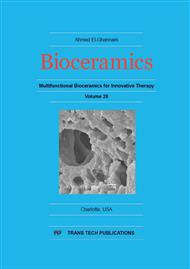p.252
p.257
p.264
p.269
p.275
p.279
p.285
p.290
p.296
Wear and Corrosion Resistance of Low Temperature Degradation Free ZTA for Artificial Joint
Abstract:
Low-temperature-degradation-free (LTD-free) zirconia-toughened alumina (ZTA) has been developed as an alternative to alumina and zirconia. It has been reported that ZTA has more beneficial mechanical characteristics than alumina, because of the stress-induced transformation and the spontaneous transformation of the zirconia phase that occurs for some ZTA in a hydrothermal environment. To achieve high-reliability artificial-joint prostheses, it is necessary to improve both the mechanical characteristics and phase stability of the joint material simultaneously. Thus, in this study, we evaluate the wear characteristics and corrosion resistance of LTD-free ZTA using a hip wear simulator, so as to confirm the long-term stability and reliability of this material in clinical use. The ZTA with advantageous mechanical characteristics used in this study has extremely high wear and corrosion resistance. Therefore, this ZTA could be quite useful as a bearing material in artificial joints for longer-term clinical use. It is also confirmed that the newly developed LTD-free ZTA is extremely stable under sliding conditions. Thus, it can be expected that the initial superior surface characteristics will be maintained through long-term clinical use.
Info:
Periodical:
Pages:
296-300
Citation:
Online since:
November 2016
Authors:
Price:
Сopyright:
© 2017 Trans Tech Publications Ltd. All Rights Reserved
Share:
Citation:


